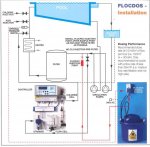Hi guys
Searching through the net i came across a video in which some one is installing their automatic dosing pump for both PH and chlorine control
Here it is:
A s you can see in 4:33 the injection valve for chlorine and ph are 20 centimeters away from each other.
I know that mixing liquid chlorine and muriatic acid at the same time would lead to chlorine gas which is deadly stuff and definetley she is following manufacturer instruction as you can see in 1:18.
Is it safe to do it like that?
It seems like this is how its done.i found the attached picture in the link below which is approved By PWTAG
Pool Water Treatment Advisory Group - Polyaluminium Chloride PAC Dosing
Thanks
Searching through the net i came across a video in which some one is installing their automatic dosing pump for both PH and chlorine control
Here it is:
A s you can see in 4:33 the injection valve for chlorine and ph are 20 centimeters away from each other.
I know that mixing liquid chlorine and muriatic acid at the same time would lead to chlorine gas which is deadly stuff and definetley she is following manufacturer instruction as you can see in 1:18.
Is it safe to do it like that?
It seems like this is how its done.i found the attached picture in the link below which is approved By PWTAG
Pool Water Treatment Advisory Group - Polyaluminium Chloride PAC Dosing
Thanks


